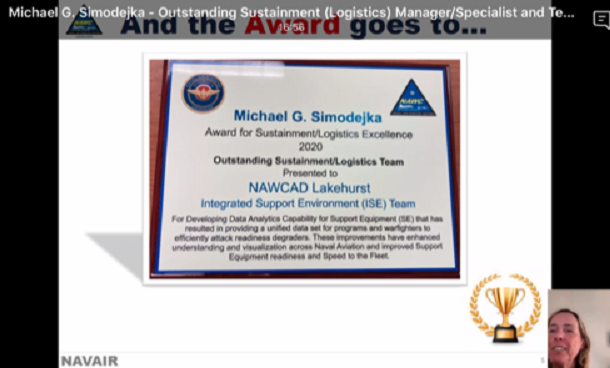Simodejka Award Goes to Lakehurst ISE Team

The Integrated Support Environment Team from Naval Air Warfare Center Aircraft Division Lakehurst was recognized in a virtual award ceremony in September as the Michael G. Simodejka Outstanding Sustainment Team of the Year for developing a single, authoritative, data-driven support equipment degrader list for each aircraft type/model/series in less than three months, the Naval Air Systems Command at Patuxent River announced.
The Simodejka award honors the legacy of the first civilian director of Naval Air Warfare Center Aircraft Division’s logistics competency and his efforts to establish logistics as a force in the command. It recognizes an individual and a team that substantively contributed to advancing life cycle logistics; applied modern technology and digital tools for sustainment, logistics and/or readiness; and enhanced the logistics profession.
Paavan Pujara, the Lakehurst ISE Team lead, credits the achievement to the team’s shared focus toward a single goal and by applying Reliability Control Board methodologies.
RCB is a data-driven approach that identifies root causes for decreased fleet readiness and determines where best to apply resources. Using this framework, the team created the SE One List/Degrader List, a list of components and maintenance processes that provides a holistic view on the health of support equipment and standardizes how degraders are identified, tracked and resolved. It also supports the SE-RCB, a group of stakeholders responsible for increasing support equipment readiness.
The SE One List/Degrader List brings together 250,000 common and peculiar end items, consisting of more than 600,000 individual pieces of equipment, to facilitate the identification, research and resolution of SE issues affecting readiness. Common Support Equipment refers to equipment that can be used on multiple aircraft or weapon systems. Peculiar Support Equipment refers to equipment that has been specially designed or created for a particular aircraft or weapon systems.
Each of these assets are used by sailors, Marines, and civilian maintenance professionals to repair and maintain naval aircraft, airborne weapons and associated equipment across naval aviation. Due to the equipment’s direct tie to the maintenance effort and associated costs, the US Navy must remain vigilant and diligent in ensuring the fleet has the right equipment at the right price.
The SE One List/Degrader List is a valuable tool used by NAVAIR support providers, program offices and the Fleet to communicate and prioritize work among all Naval Aviation Enterprise stakeholders.
Understanding the link between support equipment availability and fleet readiness, VADM Dean Peters, commander of Naval Air Systems Command, called for a standardized approach to support equipment data analytics and degrader reporting. The SE One List/Degrader List was the ISE’s response, delivering a new algorithm and method that pulls from disparate sources and provides actionable data.
“Our team collaborated with stakeholders and developed a list of criteria to consider as part of the effort,” Mr. Pujara explained. “The next part was considering various weights to assign to each attribute and/or criteria. Once that was done, we developed a model and automated scripts to generate a new list every month. We also developed a dashboard to display the result.”
The effort also produced automated algorithms that use an iterative process to minimize errors. As a result, leadership now has cleaner data to determine the best return on investment for cost and readiness.
In addition to the SE One List/Degrader List, ISE also developed supplementary visualization tools for other collaborative efforts. “Upon request, ISE performs ad-hoc, deep-dive analysis of support equipment data to include historical information and trends for integrated product teams. We use advanced data science techniques to uncover information that may be obscured and help stakeholders better understand and explain the issues to decision makers,” Mr. Pujara said.
The team continues to refine its work.
Currently, it is reaching out to users to provide them with additional information on the RCB process, how to read and interpret the visualization tools and better understand the impact of their day-to-day activities on data analysis.
“We are also developing several Naval Innovative Science and Engineering projects using the data and information we are collecting to improve data analytics capabilities that drive decisions and improve Fleet support for the future,” he said. “One project currently underway seeks to tie support equipment degraders to the program-RCB degraders. This will establish support equipment’s ‘value’ in terms of aircraft readiness.”
Leslie Taylor, executive director of the Naval Air Warfare Center Aircraft Division, commended the team during the ceremony for quickly creating a product with immediate application.
“The SE One List/Degrader List provides a means to attack support equipment issues across naval aviation and contributes to the fleet to make sure they have what they need when they need it,” she said.
Mr. Pujara said creating the SE One List/Degrader List was made possible by each team member’s personal commitment to excellence and a can-do attitude.
“Everyone had a voice in this effort, sharing their knowledge, experiences, insights and perspectives,” he explained. “Engagement by all stakeholders, no matter what the mission, is what it takes to get the job done.”
This article was provided by NAVAIR News.























